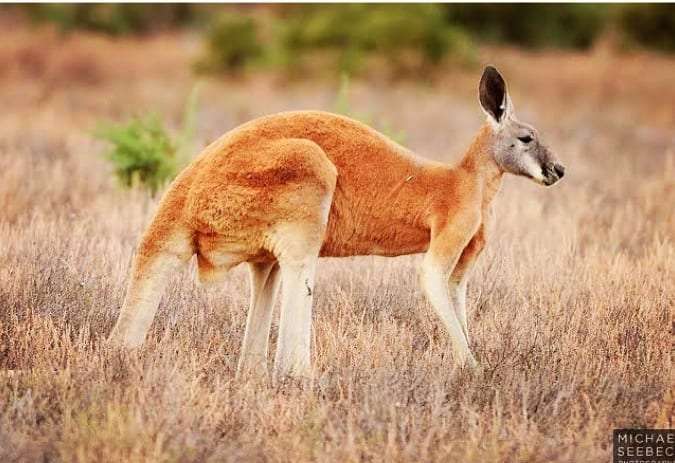Kangaroos are one of the most recognizable creatures on earth. They’re large, furry marsupials with powerful legs and massive tails. There are currently four kangaroo species on earth, and they all have similar physical traits.
Although many kangaroos are in the same family as wallabies and wallaroos, those that are larger belong to a different species, giving them an overall size that puts them into unique genera and species.
Generally, wallabies are small kangaroos, tree kangaroos are not part of the four accepted kangaroo species despite some similarities.
Below we list four different types of kangaroos in order from smallest to largest.
Kangaroos are one of the best examples of sexually dimorphic animals. Males generally have a larger size than females. Keep in mind that the listed measurements below are done on males because they are more common.
Top 4 Largest Kangaroo Species
1. Antilopine Kangaroo

photo: barechested_birdnerd
| Avg. body Length | 3.9 ft. long (1.2 m) |
| Avg. Height | 3.6 ft. tall (1.1 m) |
| Avg. weight | 85-108 lbs. |
| Avg. tail Length | 2.95 ft. long (0.9 m) |
On average, the Antilopine kangaroo is smaller than the other 3 kangaroo species. This species lives along the North Australian coast from Cape York to Kimberly region. It is sometimes referred to as the “Antilopine wallaroo”. The Antilopine Kangaroos are gray in color and the underbelly is usually cream-colored. These social grazers are most often found in groups like other kangaroos.
The Antilopine is a kangaroo with many interesting features. The main one is that its feet are large and the long muscular tail helps keep its balance when hopping around. They have a pouch for their young, but it’s smaller than most other kangaroos’. Its head is also small, there are big floppy ears, and the eyes have very large pupils.
2. Western Grey Kangaroo

photo: ambikangela
| Avg. body Length | 2.75-3.6 ft. long (0.84-1.1 m) |
| Avg. tail Length | 2.6-3.3 ft. long (0.8-1 m) |
| Avg. Height | 4.26 ft. tall (1.3 m) |
| Avg. weight | 62-120 lbs. |
This Western Grey Kangaroo is a fairly common marsupial found in Australia. It lives primarily on the southern coast and parts of its range are shared with even larger Eastern Grey Kangaroos, but they do not actually crossbreed in the wild.
The western grey Kangaroo is normally slightly smaller than its eastern counterpart. They have a coat that is mostly grey to brown and paler shades that are found on the chest, belly, and front of their neck. It is difficult to differentiate them from the eastern Grey Kangaroos, but western Grey Kangaroos usually have darker fur colors browns, and greys.
3. Eastern Grey Kangaroo

photo:stephenhunter6
| Avg. body Length | 4.26 ft. long (1.3 m) |
| Avg. tail Length | 3.3 ft. long (1 m) |
| Avg. height: | 4.9 ft. tall (1.5 m) |
| Avg. weight | 110-146 lbs. |
Eastern grey kangaroos are the 2nd largest species of Eastern Australia. There are also populations of kangaroos on the island of Tasmania. The habitat range of the eastern grey kangaroo overlaps with the red one, but it is easy to differentiate because it has a softer and greyer coat.
There was a tendency for the eastern grey kangaroos to be crepuscular and prefer wetter climates than the red variety. This was made clear by the fact that they are active during twilight. Most eastern greys take a siesta around the heat of the day. One female kangaroo set a new kangaroo record by reaching 40 miles per hour, though other speed records are maintained as well specifically in different areas.
4. Red Kangaroo

photo: georgecarr_snaps
| Avg. body Length | Up to 5.25 ft. long (1.6 m) |
| Avg. tail Length | 3.9 ft. long (1.2 m) |
| Avg. height | 5.9 ft. tall (1.8 m) |
| Avg. weight | 121-198 lbs. |
The red kangaroo is one of the largest species of kangaroos and is also the country’s national animal. It can be found in most land areas, especially around Australia’s interior.
The red kangaroo is a species native to Australia and prefers more arid climates with scrubland, grasses, and the occasional tree grove to shelter under. Red Kangaroos are also a highly adaptive species–natural adaptors–which mean they adjust well to human presence while sometimes eating into farmed crops.”
These kangaroos are one of the most powerful mammals and may not seem intimidating when you first see them, but their arm and leg strength is something to be taken seriously! Male kangaroos often fight on land and by leaping off of other kangaroos, boxing with their arms & legs.
When the red kangaroo kicks, it uses its tail to stabilize on the ground and fight other males who are trying to gain access. The males usually only fight over females and Reds that lose these fights will only live in isolation, if they can escape at all.

Leave a Reply